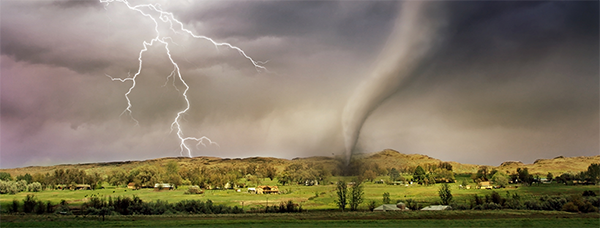No matter where your insurance client (or your entity, if you’re self-insured) is located, there’s always the risk of a natural or man-made disaster. Of course you’re aware of this – that’s why you have property insurance. Whether it’s tornadoes in the Midwest, floods in Texas or fires in New Mexico, Arizona and California, disasters seem to occur on a regular basis. Does your enterprise have a business disaster recovery plan to keep you humming, no matter what? A recent national survey of 300 senior business professionals revealed that less than a quarter of businesses felt they were “very well prepared” to address challenges related to extreme weather or a natural disaster. Moreover, one third of respondents admitted they didn’t have a formal disaster recovery plan in place.
Both the Insurance Institute for Business & Home Safety (IBHS) and the U.S. Small Business Administration have created easy-to-follow checklists and kits to help you as a business owner prepare for any kind of business interruption, so that you can quickly reopen and resume business following a disaster. We recommend you download them (they’re free) and put them to good use. Here’s a brief overview of what you’ll find inside both kits: step-by-step instructions followed by downloadable forms you can use in your preparedness planning.
What are your primary risks to cover in your business disaster recovery plan?
First up is identifying your business risks, and then ranking them by severity and probability. These threats can range from earthquake or flood, to power outages, workplace violence and more. Your county may be able to provide a local hazards vulnerability analysis that will give you insight as to potential natural and manmade hazards for your area. Those that you rank the highest should be your first risks for which to nail down a plan. Next, consider the impact of these threats on your enterprise:
- How will they impact your ability to do business?
- If one should occur, who would you need to contact?
- Which of your business functions could be handled remotely, by employees at home?
- Which of those functions have legal, contractual or regulatory aspects that you must continue to fulfill while your business is impaired?
- What work-arounds can you deploy for each of those functions, to keep your business humming?
- How will you protect your computer systems and data? Data storage firms offer offsite backups of computer data that can be updated regularly via the internet.
- Will you need a back-up location to operate out of, until your main building is repaired? If you cannot afford to shut down your operations, even temporarily, determine what you require to run the business at another location.
Related: Do you have a business continuity plan?
Third, should the disaster occur during work hours,
- Have you created an evacuation plan with pre-arranged meeting spots, and does everyone know your plan? View the “What to take when you evacuate” checklist created by Agility Recovery.
- Have you developed a shelter-in-place plan for such emergencies as a tornado or flood? Again, do all employees know where those safe places are?
Include a communications sequence in your business disaster recovery plan
Fourth, think about how you will communicate with employees, customers, vendors and other contacts:
- Do you have all employees’ emergency contacts?
- Do you have a list of employee home and mobile phones and personal email addresses – and is a copy stored offsite?
- Do they know how to contact you to find out if your business is open or how long it will be closed?
- Can you access a customer list offsite, should you need to email them about the situation? How will you handle communications to ensure you don’t lose any customers?
- Can you also access a list of vendors and business partners from offsite, including, for instance, your insurance agent, your bank, payroll service, internet service provider and more?
- View Agility Recovery’s Crisis Communications checklist for communicating with each group
Other risks and issues to consider
Speaking of the internet, you’ll want to ensure you have access to all passwords and logins offsite. What data is crucial to keeping your business going? Create backups on more than one medium, such as thumb drive and Cloud. Back up computer files, specifically accounting, payroll, tax and other pertinent records. It’s also a good idea to keep a backup copy of each computer’s operating system, boot files and critical software. Finally, you’ll want to keep a current inventory of all computers, printers and other digital equipment, including serial numbers.
Related: 4 Pandemic Employment and Tech Trends Challenge Insurers
Also think about how you will bankroll your business during this time. Consider an emergency cash reserve fund and have a line of credit or a business credit card available. Create a payroll continuity plan so that employees know what to expect. Talk with suppliers, utilities, your landlord, etc. and work out an interim payment plan if necessary. And of course, report your losses asap so that your claims adjuster can get your case moving quickly.
Both kits from the SBA and IBHS not only provide forms to help with planning, they also provide a scenario to help you hone and test your preparedness plan. Additionally, the SBA kit provides specific checklists for various disasters, from hurricanes to winter weather, to wildfire or earthquake and more.
Resources: Developing a Small Business Disaster Recovery Plan How to create a disaster recovery plan for your business
This article originally appeared on the blog of our sister company, American Claims Management. It has been modified and updated to better fit the needs of PGCS’ clients.

